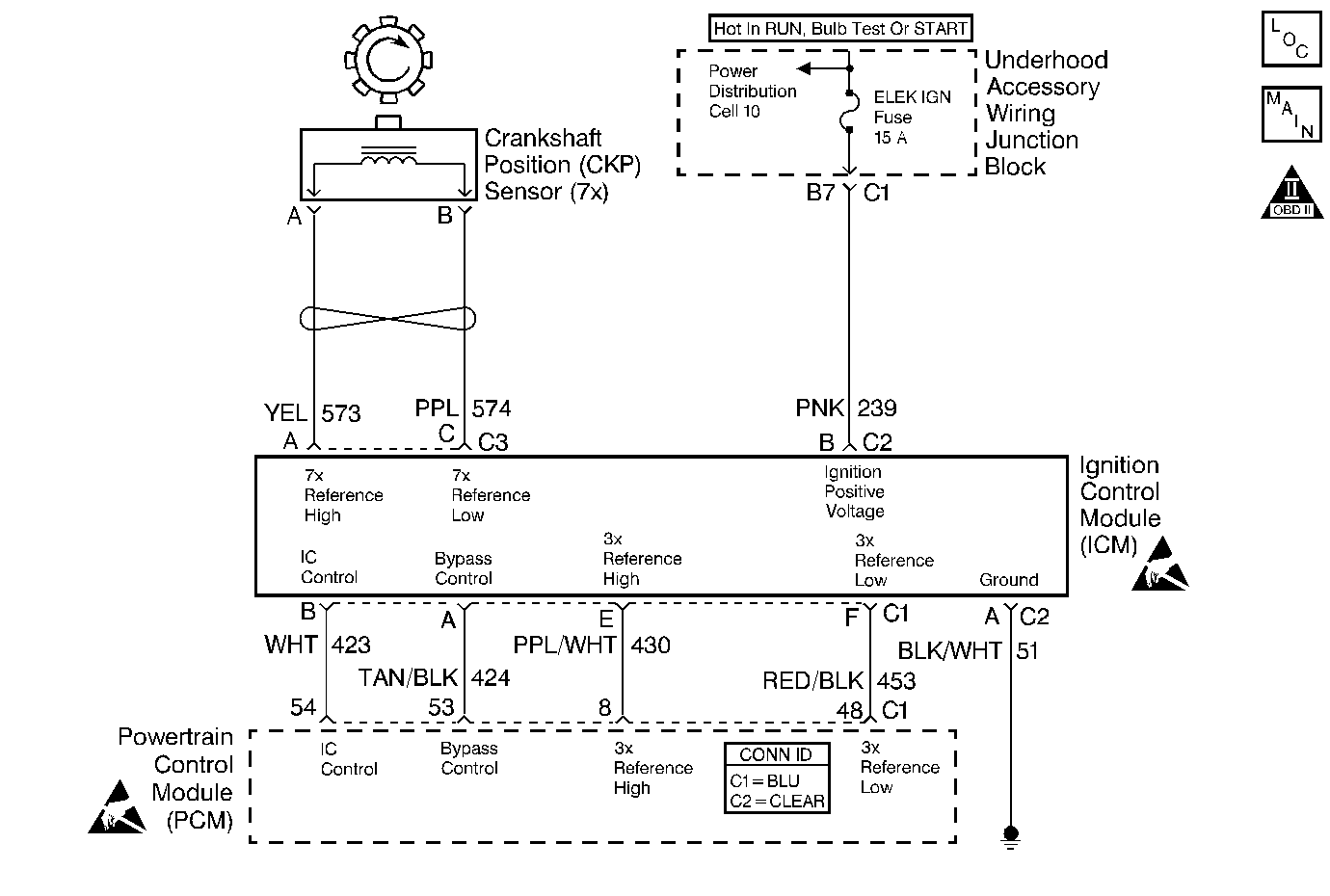
Circuit Description
The 3X reference signal is produced by the Ignition Control (IC) Module. The IC Module calculates the 3X reference signal by dividing the Crankshaft Position (CKP) sensor 7X pulses by 2 when the engine is running and the CKP synchronizing pulses are being received. The PCM uses the 3X reference signal to calculate the engine RPM and the crankshaft position at engine speeds above 1600±150 RPM. The PCM also uses these pulses to initiate injector pulses. The PCM compares the 3X reference pulses to the 24X CKP pulses and the CMP pulses. If the PCM receives an incorrect number of pulses on the 3X circuit a DTC P1374 will set and the PCM will use the 24X CKP reference circuit for fuel and ignition control. The engine will continue to start and run using only the 24X CKP and Camshaft Position Sensor signals.
Conditions for Running the DTC
The engine is running (24X reference pulses are being received).
Conditions for Setting the DTC
| • | The ratio of 24X reference pulses to 3X reference pulses received by the PCM does not equal 8. |
| • | The ratio of 24X reference pulses to camshaft position PCM input pulses received by the PCM equals 48. |
| • | The conditions are present for greater than 10 seconds. |
Action Taken When the DTC Sets
| • | The PCM illuminates the malfunction indicator lamp (MIL) on the second consecutive ignition cycle that the diagnostic runs and fails. |
| • | The PCM records the operating conditions at the time the diagnostic fails. The first time the diagnostic fails, the PCM stores this information in the Failure Records. If the diagnostic reports a failure on the second consecutive ignition cycle, the PCM records the operating conditions at the time of the failure. |
| • | The PCM writes the conditions to the Freeze Frame and updates the Failure Records. |
Conditions for Clearing the MIL/DTC
| • | The PCM will turn OFF the malfunction indicator lamp (MIL) during the third consecutive trip in which the diagnostic has run and passed. |
| • | The history DTC will clear after 40 consecutive warm-up cycles have occurred without a malfunction. |
| • | The DTC can be cleared by using a scan tool. |
Diagnostic Aids
DTC P1374 can be caused by secondary components leaking high voltage into the IC Module. Check for the following conditions:
| • | Incorrect harness routing near secondary ignition components. |
| • | Ignition coil arcing to wiring harness or IC Module (check ignition coils for cracks, carbon tracking, or other signs of damage). |
| • | Secondary ignition wire(s) arcing to wiring harness. |
| • | The MAP Sensor reading will freeze when the 3X signal is lost. |
| • | After the MAP sensor freezes, DTC P0101 Mass Air Flow (MAF) Sensor Performance may set due to the incorrect MAP Value and the engine may be hard to start (possible long crank). |
| • | Eventually (after a long crank) a DTC P0108 Manifold Absolute Pressure (MAP) Sensor Circuit High Voltage may also set and replace the MAP Sensor value with a default value and the engine will start and regain some performance. |
Inspect for the following:
Important: : Remove any debris from the connector surfaces before servicing a component. Inspect the connector gaskets when diagnosing or replacing a component. Ensure that the gaskets are installed correctly. The gaskets prevent contaminate intrusion.
| • | Poor terminal connection. |
| Inspect the harness connectors for backed out terminals, improper mating, broken locks, improperly formed or damaged terminals, and faulty terminal to wire connection. Use a corresponding mating terminal to test for proper tension. Refer to Intermittents and Poor Connections Diagnosis , and Connector Repairs Wiring Systems. |
| • | Damaged harness. |
| Inspect the wiring harness for damage. If the harness appears to be OK, observe the sensor display on the scan tool while moving connectors and wiring harnesses related to the sensor. A change in the sensor display may indicate the location of the fault. Refer to Wiring Repairs in Wiring Systems. |
| • | Inspect the PCM and the engine grounds for clean and secure connections. |
If the DTC is determined to be intermittent, reviewing the Fail Records can be useful in determining when the DTC was last set.
Step | Action | Value(s) | Yes | No | ||||||
|---|---|---|---|---|---|---|---|---|---|---|
1 | Was the Powertrain OBD System Check performed? | -- | ||||||||
2 | Attempt to start the engine. Does the engine start and continue to run? | -- | ||||||||
3 |
Does the scan tool indicate DTC P1374 failed this ignition? | -- | Go to Diagnostic Aids | |||||||
4 |
Install J 34730-380 Injector Harness Load Tester. Does the J 34730-380 Injector Harness Load Tester blink? | -- | ||||||||
5 |
Was a problem found? | -- | ||||||||
6 |
Did terminal need to be replaced? | -- | ||||||||
7 |
Was a problem found? | -- | ||||||||
8 |
Did any terminals need to be replaced? | -- | ||||||||
9 | Replace the IC Module. Refer to Ignition Control Module Replacement . Is the action complete? | -- | -- | |||||||
10 |
Important: : Replacement PCM must be programmed. Refer to Powertrain Control Module Replacement/Programming . Replace the PCM. Is the action complete? | -- | -- | |||||||
11 |
Does scan tool indicate DTC P1374 failed? | -- | System OK |
